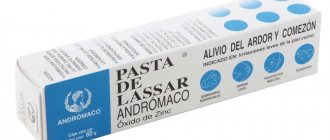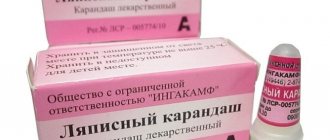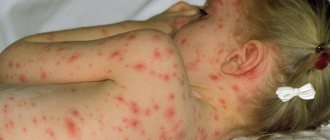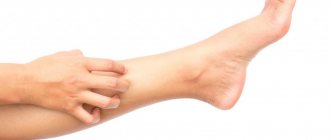Category: Adults Published 05/22/2018 · Comments: · Reading time: 5 min · Views: Post Views: 2,430
Doctors recommend lubricating chickenpox rashes with brilliant green to prevent the spread of infection. The solution only has a disinfecting effect, leaving green traces. When faced with the disease, older patients try to find a colorless remedy for chickenpox. Pharmacies offer various topical preparations that do not stain the skin, which not only have a drying effect, but also alleviate the patient’s condition.
Chickenpox is a serious infectious disease that causes discomfort caused by itching and fever. Usually, people get sick in childhood, but adults are also at risk of infection (if there is no acquired immunity).
Replacing brilliant green
Chickenpox is a disease accompanied by rashes throughout the body. The rash is subject to inflammation and severe itching.
In our country, the most common and popular medicine for getting rid of pimples due to chickenpox is the “diamond green” solution - ordinary brilliant green. What are the advantages of this method?
Positive sides:
- Has a drying effect,
- Destroys microbes on the surface of the skin,
- It is easy to determine which of the bubbles are new,
- Cheap.
This method is used in many families and is considered effective and efficient. But many doctors believe that instead of brilliant green it is better to use other drugs for chickenpox.
Negative sides:
- The medicine contains alcohol and dries out the skin.
- Does not fight the chickenpox pathogen.
- Green marks on the skin make young children smile; older children are embarrassed by their appearance, which has an adverse effect on their mental state.
- The brilliant green solution leaves marks on clothes and bedding. It is quite difficult to wash off and stays on for a long time.
Zelenka is an excellent, inexpensive remedy for chickenpox, but there are medications that have a wide range of actions.
Features of the drug "Fukortsin"
Before treating chickenpox with Fukortsin, you should familiarize yourself with its features. This transparent, colorless liquid "Castellani" is used externally and acts in the fight against fungi and bacteria. It has a pronounced phenolic odor and can be red in color, which remains on the skin in the form of pink spots. After treating the ulcers with this medication, the patient may feel a slight burning sensation.
The drug Fukortsin
Fukortsin is used not only for the treatment of chickenpox, but also for the treatment of ulcerative lesions, abrasions, wounds, pustules, erosions and fungal infections. In childhood, it is prescribed with caution exclusively by a doctor, since children have increased sensitivity to the components of the medication. You should also use it with caution because it contains phenol, a toxic component that can harm your baby. The colorless solution "Fukortsina" is used for spot treatment of areas of the skin where there are ulcers.
How to apply chickenpox (except brilliant green)
What to smear on pockmarks besides brilliant green? What to choose? Below is a list of medications prescribed for the treatment of chickenpox.
Fukortsin.
It has pronounced antiseptic and antifungal properties. Released in the form of a solution. The medicine has a bright pink color. You can smear rashes on babies and newborns. Apply to the skin with a cotton swab up to four times a day. After the drug has dried, additional medications can be applied. Contraindications for use are intolerance to the components, pregnancy and breastfeeding. Use on mucous membranes should be accompanied by caution. It is not recommended to smear large surfaces with the solution to avoid phenol poisoning. With prolonged use it is addictive and does not have the necessary therapeutic effect.
Potassium permanganate solution 5%
For chickenpox, a weak solution of this substance is used. You need to apply it pointwise, every pimple. However, potassium permanganate cannot be found on the open market; it can only be purchased by prescription.
Tsindol
A solution often used for chickenpox and other skin diseases. The suspension relieves swelling, reduces itching, dries blisters, and is an antiseptic and antibacterial agent. Before use for chickenpox, shake the bottle and apply the drug with a cotton swab to the rash. It is necessary to smear the rash every 4-6 hours. A contraindication to the use of the medicine is intolerance to the ingredients. Tsindol does not cause side effects and is approved for use in children.
Calamine
Similar to Tsindol, but more expensive in price. The composition contains calamine and zinc oxide. It is used for chickenpox, dermatitis, sunburn, insect bites and various skin ailments. Calamine lotion relieves inflammation, irritation, reduces swelling, reduces itching, and stimulates skin regeneration. Calamine is applied to the rash using a cotton swab or cotton pad. It has no contraindications except for allergies to its constituent elements, and does not cause side effects.
Poksklin
It is a gel for application to the skin. Has a drying, antibacterial, antipruritic effect. Quickly reduces the number of pimples caused by chickenpox and prevents new ones from spreading. The drug is easy to apply on rashes and does not cause side effects. Not approved for use in children under two years of age. Contraindication is intolerance to the components. The downside of the medicine is its high cost and the need to use it within thirty days after opening the bottle.
Acyclovir
An ointment with an antiviral effect, suppresses the effect of the disease virus. It is allowed to smear the rash from the first day of its appearance. The duration of therapy is five days, used up to six times a day in adults and children. Acyclovir ointment may cause certain side effects. Use of the product is permitted as prescribed by a specialist.
Infagel
Has anti-inflammatory, antipruritic, anti-edematous effects. Reduces the activity of the virus, increases immunity. Doctors advise applying Infagel to pimples at the stage of redness, when there are still no bubbles with liquid. Not for use in children under three years of age.
Zinc ointment and pastes
These drugs have a clear anti-inflammatory and antibacterial effect. They relieve irritation and itching. They have wound healing properties.
Many people are interested in what will happen if iodine is used for chickenpox? You should know that you should not smear iodine on rashes. This approach will lead to an exacerbation of the disease, the appearance of quite severe itching and dry skin.
Why are dyes used for chickenpox?
The rash causes discomfort to the patient and is accompanied by an increase in body temperature and unbearable itching. To get rid of an infection, it is not necessary to use medications. It is enough to maintain hygiene, change bed linen daily, do not comb the blisters that form, and chickenpox will go away on its own.
But often the disease occurs in childhood, causing discomfort to young patients. There is a high probability that without treatment with medicinal ointments and creams, the child will scratch the area where the rash appears. It is also necessary to protect wounds from re-infection. At the same time, it is necessary to eliminate the accompanying symptoms.
If you regularly use brilliant green for treatment, you can track the moment when new spots stop forming and the healing process begins. The same applies to the use of Fukortsin, a bright raspberry lotion that leaves pink spots on the skin. It is often used instead of brilliant green in the treatment of chickenpox. And children prefer the pink color of the medicine instead of dark green.
When using a colorless remedy for chickenpox, it is difficult to understand when recovery begins and the rash stops spreading.
How many days to apply chickenpox
How many days to smear the chickenpox rash. Doctors advise starting treatment of inflamed areas from the appearance of the first pimple and continuing until the last scab falls off.
On average, you need to smear the lesions twice a day.
If rashes occur on the mucous membranes, the drugs described above cannot be used. You can treat wounds with a solution of miramistin or chlorhexidine.
Operating principle, selection criteria
The choice of ointments for children that can be used for chickenpox instead of brilliant green is quite wide. Most of them are aimed at alleviating symptoms and preventing complications.
To understand the names, let's try to classify them into groups:
- Zinc preparations. Products based on zinc dioxide, which relieves productive symptoms and soothes the skin. Promotes rapid maturation and opening of acne, accelerates the recovery process: wounds disappear in a short time (Zinc ointment, Calamine).
- Antiviral agents.
They help inhibit the activity of viral agents, reducing the risk of extensive spread of the disease. They help reduce the duration of the acute phase of chickenpox from 2-3 weeks to several days (Acyclovir, Oxolin, Infagel, tea tree oil). - Antiallergic drugs. They can be used for chickenpox, but will not always be effective . Sometimes the symptoms of chickenpox overlap with symptoms of allergies, and vice versa. Antihistamines relieve itching, reduce inflammation and pain. Such drugs do not penetrate the bloodstream, therefore they have virtually no side effects (Fenistil, Fukortsin).
- Anti-inflammatory (non-steroidal). Used in combination with other drugs. Pain, irritation and itching are the consequences of inflammation of the upper layers of the dermis. Thanks to anti-inflammatory drugs, local symptoms are relieved and the general condition is alleviated (Salicylic ointment, Ibuprofen, Kamistad).
Another category is ointments that help eliminate scars and scars - the consequences of chickenpox. These include drugs such as Contractubex, Dermatix, Mederma.
Folk remedies for chickenpox
Often parents cannot decide on the choice of remedy for chickenpox in a child. You can alleviate the condition with the help of traditional medicine.
Facilities:
- You can smear the rash with a solution of soda, this will help relieve inflammation and itching.
- Applying tea tree essential oil to pimples with a cotton swab helps relieve inflammation and itching. The oil has a disinfectant effect.
- The patient should take baths with the addition of decoctions of calendula and chamomile.
- You can smear the skin with a decoction of oats, this will help reduce unpleasant symptoms.
- Apply a gauze pad soaked in a decoction of celandine to severely itchy areas for several minutes.
- The same procedure is carried out with a napkin soaked in a starch solution.
- Rash on the mucous membranes due to chickenpox can be smeared with sea buckthorn oil or wiped with a piece of ice.
Traditional medicine is full of recipes for remedies that help with smallpox. It must be used carefully to avoid allergic reactions and exacerbation of the disease.
Indications for use
Chickenpox ointments should be used only on the damaged area of the skin. Most often, the first signs of this disease appear on the face, after which they spread throughout the head and entire body. Outwardly, such formations resemble pimples, inside of which there is a cloudy liquid. The sooner you start using anti-chickenpox remedies, the faster you will be able to dry out the formations and completely get rid of traces of the infection.
It is best to start using chickenpox ointment as soon as itching appears. This way you can prevent injury to the skin and eliminate the possibility of scars appearing on it in the future. In addition, special components from the ointment contribute to more accelerated tissue restoration, painless healing, relief of inflammation and removal of all bacteria.
General rules for the treatment of chickenpox
How to treat chickenpox? Doctors prescribe various medications for therapy.
Medicines:
- Antipyretic drugs help cope with high fever.
- If the rash is severe, antihistamines are prescribed to reduce unpleasant symptoms.
- External medications are used to reduce the number of rashes.
Most chickenpox treatment is carried out at home.
Recommendations:
- Staying in bed for a week
- Apply to rashes daily
- Constant change of clothes and bed linen,
- Pay attention to your diet, include more fruits and vegetables,
- Frequent ventilation of the room,
- Small children wear thin mittens to avoid scratching wounds.
Following the recommendations will help speed up your recovery.
What is the best way to apply to chickenpox rashes? There is no clear answer to this question. The specialist will select the most suitable drug individually in each case. It is worth remembering that self-prescription of medications is fraught with exacerbation of the disease.
Rules for treating chickenpox in a child
Treatment of chickenpox has certain subtleties, especially when identifying the disease in children. Before giving your baby medications, study the principles of therapy.
1. As soon as you notice a rash, it needs to be dealt with immediately. Antiseptics are used to treat stains.
2. If a small patient complains of unbearable itching, it is advisable to introduce antiallergic medications.
3. You cannot lower the temperature if it has not risen above 38 degrees. For high levels, antipyretics are used, such as Nurofen or Ibuprofen. Products containing acetylsalicylic acid and paracetamol are not given to children.
4. It is prohibited to make a diagnosis and carry out treatment on your own. As soon as you notice that your baby has developed a rash, call your local doctor. An initial consultation with a specialist is required.
5. For therapy to be as effective as possible, it is important to know not only how to treat chickenpox, but also to use auxiliary methods. The child should have proper nutrition, based mostly on plant foods.
6. If chickenpox is confirmed and is in an acute form, attending public events is prohibited. You should also avoid walking in the fresh air. The baby requires strict bed rest.
7. The rashes are very itchy, and children do not miss the opportunity to alleviate the condition. Because of this, scars often appear on the skin. Talk to your child and ask him not to scratch the wounds. If scars appear, use Contractubex.
What medications can be used to get rid of scars?
Often, after chickenpox, scars of various sizes remain on the body, especially if the rash is scratched heavily. This effect occurs more often in adults than in children, since their skin is not so actively renewed. So, to eliminate the consequences of the disease, you can use:
- ointment Kontraktubek s - the use of this drug reduces the severity of skin deformation, leads to leveling of the surface of the scar relative to the surrounding skin, and also softens the stiffness of the tissues. The product can increase the elasticity of scar tissue, restoring its regenerative abilities. The ointment contains allantoin, sodium heparin and Serae onion extract. The product should be applied exclusively to the scars themselves 2-3 times a day, accompanied by light rubbing;
- Mederma is a gel for external use based on Serae onion extract and allantoin. Suitable for combating scars and scars up to a year. It is recommended to apply the gel topically 3 times a day, followed by rubbing until completely absorbed;
- Dermatix is a silicone gel that is designed to combat already formed scars, and is also suitable for old scars. The composition is applied to the area, previously washed with soap and water and thoroughly dried, and allowed to dry completely on its own. The procedure is carried out twice a day for two months.
Separately, it is worth noting a large group of ointments based on dexpanthenol (D-Panthenol, Panthenol, Panthenol-Ratiopharm, etc.). Depending on the manufacturer, these products may have a number of auxiliary components, for example, sea buckthorn oil, triglycerides, lanolin, citric acid, etc. To achieve high-quality results in the fight against scars after chickenpox, white ointment is applied in a thin layer twice a day to still fresh scars. The active component will help relieve the inflammatory process and also lead to rapid skin regeneration.
Types of ointments
Chickenpox is transmitted by airborne droplets. It is provoked by Varicella Zoster virus (herpes virus type 3). The disease is accompanied by fever and signs of general intoxication. To eliminate the possibility of secondary infection, eliminate itching and swelling, and speed up the healing of rashes, a patient with chickenpox is prescribed various groups of ointments. If you do not treat the skin, then due to strong scratching, healing may take a long time.
In most cases, the rash is smeared with brilliant green. It helps not only prevent bacterial complications, but also easily detect the appearance of new rashes. In addition to brilliant green, the following ointments are used to treat rashes:
| Group of drugs | Examples of drugs |
| Antiviral |
|
| Antihistamines |
|
| Homeopathic |
|
| Zinc based |
|
| Anti-inflammatory |
|
| Healing and for scars |
|
List of colorless rash treatments
Colorless preparations, available on the Russian market in large quantities, can replace brilliant green for chickenpox. They act purposefully, providing a comprehensive effect on wounds and eliminating unpleasant symptoms upon first use.
Products in liquid form
Medicines in the form of a colorless liquid are applied using a cotton pad or swab. The rash is treated with drugs such as:
- "Castellani-Gefe" is a solution used externally and is classified as an antiseptic. Apply directly to spots 3-4 times a day. You should avoid using the liquid on large areas of the skin, as the solution is toxic and can cause a negative reaction. Its use in the treatment of children under 12 years of age is strictly contraindicated. Use with caution for allergic diseases.
- Salicylic acid solution - treatment with a mixture of salicylic acid and ethyl alcohol in a certain proportion (1%) promotes rapid healing of wounds, dries and soothes irritated areas. Do not apply the solution to healthy skin, as there is a high risk of burns. The rashes are treated locally a couple of times a day with cotton swabs.
- "Calamine" - a cosmetic lotion relieves itchy scratching of the rash, cools and dries the blisters, protecting them from infection. When it dries, it leaves a white coating on the skin.
- Tea tree oil is a plant substance that has an anti-inflammatory and antimicrobial effect against chickenpox. By choosing the oil of the desired concentration, you can stop the inflammatory process and reduce the symptoms of itching.
- A solution of potassium permanganate is a pale pink liquid that is used to treat the bubbles. Almost every housewife has this powdery substance on hand and is inexpensive.










